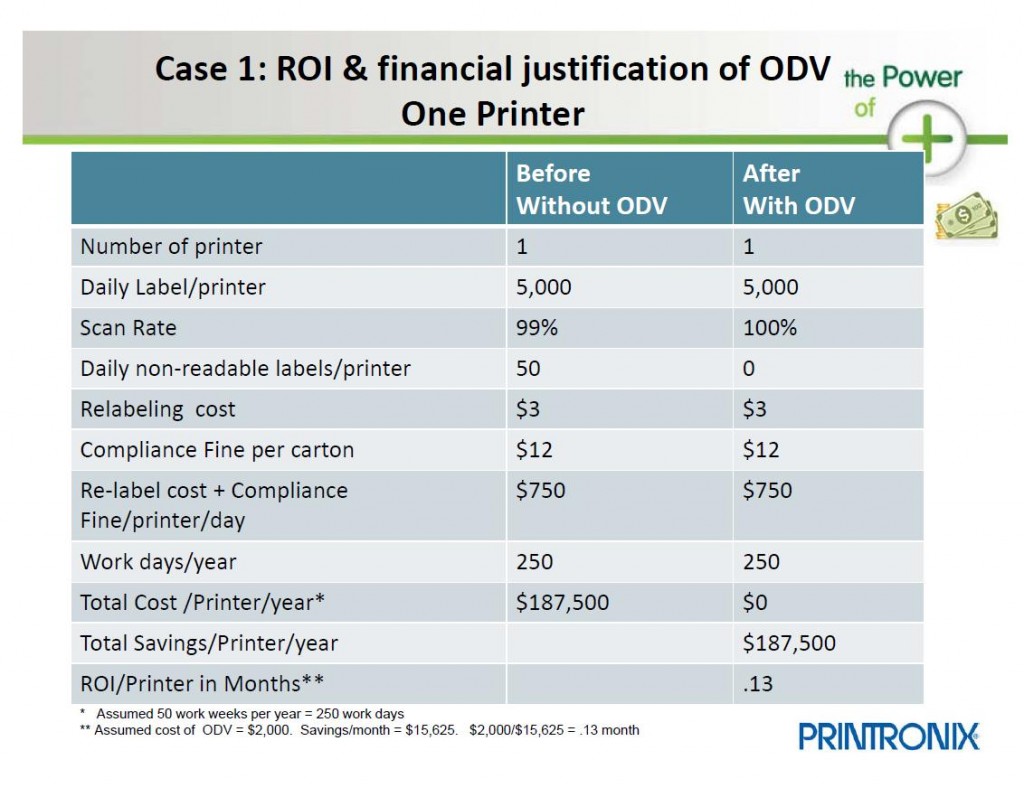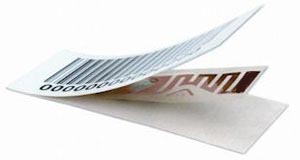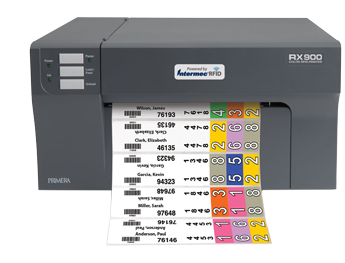Printronix RFID: Prevent Compliance Fines with Online Data Validation
 Printronix has built a reputation for building top-of-the-line line matrix and thermal barcode printers and is doing the same with their superb line of RFID printers which are becoming some of the top devices in the RFID industry.
Printronix has built a reputation for building top-of-the-line line matrix and thermal barcode printers and is doing the same with their superb line of RFID printers which are becoming some of the top devices in the RFID industry.
What makes the Printronix RFID printers, the SL5000r and SL4M, unique is their ability to incorporate Online Data Validation (ODV) to their RFID printing solution. ODV technology ensures that all barcodes being printed are meeting the most stringent standards set by vendors such as Walmart and the Department of Defense. Maintaining compliance prevents hefty fines that can range up to $20 per box plus the cost to rework, pack and ship the corrected boxes. Thus, a return on investment for a Printronix RFID printer can be achieved on as a little as one poorly labeled shipment.
To learn more about the Printronix RFID printer or how ODV works, please contact one of our Barcodes Inc RFID experts.
Bartender RFID: The RFID Printing Software of Choice
 Seagull Scientific’s Bartender has gained notoriety for providing the best label design software on the market. However, Bartender RFID includes the same label design features, along with encoding capabilities that offer the same ease of use. Bartender RFID Enterprise Automation and Automation’s rich feature sets include supporting most of the popular RFID printers, supporting most of the label types available (Gen2, EPC Class 1, ISO 15693, etc.) and allows data to be encoded in most of the common formats (DoD, SSCC, GIAI, etc.).
Seagull Scientific’s Bartender has gained notoriety for providing the best label design software on the market. However, Bartender RFID includes the same label design features, along with encoding capabilities that offer the same ease of use. Bartender RFID Enterprise Automation and Automation’s rich feature sets include supporting most of the popular RFID printers, supporting most of the label types available (Gen2, EPC Class 1, ISO 15693, etc.) and allows data to be encoded in most of the common formats (DoD, SSCC, GIAI, etc.).
Seagull Scientific continues to lead the way in innovation when it comes to barcode and RFID printing software. Consequently, Barcodes Inc recommends Bartender RFID in our RFID printing systems in order to provide a low cost, quality solution.
For more assistance finding the right RFID printing software for your needs, contact us at Barcodes Inc.
Zebra R2844-Z Discontinuance Notice
Zebra has announced the discontinuance of the R2844-Z desktop HF RFID printer. No orders for the product will be accepted after October 30, 2013 unless inventory is still available. Orders placed for these units by October 30 will ship by their desired delivery dates, subject to production lead times.
Service, parts and support will continue to be available for approximately three (3) years from the last date of shipment—approximately until December 31, 2016.
No replacement product for the R2844-Z desktop HF RFID printer is planned at this time. However, a new desktop UHF RFID printer is planned for launch later this year. Additional information on this new printer will be provided at launch.
For assistance finding the right RFID Printer for your application needs, contact us at Barcodes Inc.
Zebra Achieves Oracle Validated Integration With Oracle’s JD Edwards EnterpriseOne 9.1
Zebra, a recognized global leader in technologies that extend real-time visibility into business operations, and a Gold level member of Oracle PartnerNetwork, announced it has achieved Oracle Validated Integration between its thermal barcode and RFID printer product line and Oracle’s JD Edwards EnterpriseOne 9.1.
Zebra printers communicate with JD Edwards EnterpriseOne via the Zebra barcode printing solution, providing direct capabilities to seamlessly receive and process XML output from JD Edwards EnterpriseOne more quickly. By eliminating printing delays, customers save valuable time and money, and improve operational efficiencies.
Smart Printers. Smart Investment.
People generally relate to industrial printers as they do to their desktop printers. It’s a “dumb” device that prints whatever a computer sends it. As long as it does that well and keeps working, people really don’t think too much about it.
Bar code printers have generally fallen into the same “dumb” and reliable category, but are also rugged and fast at producing labels.
However, there is a different type of industrial-strength printer that’s in a class by itself. It has the same characteristics as other bar code printers—rugged, fast, and reliable—but these printers are “smart.” Smart printers have built-in intelligence that enables them to perform a wide variety of operations that normal printers cannot.
First, smart printers do not require a computer to be able to produce labels. The immediate benefits are you save the cost of a computer dedicated to controlling the printer and you save space by reducing the number of devices needed to perform operations. Smart printers’ intelligence also allows them to actually run processes and devices. Smart printers can act as programmable logic controllers (PLC) to run other devices in production applications.
Smart printers are not new; they have been manufactured for over a decade. The latest generation delivers even more capability than before, adding advanced bar code printing capabilities, errorproofing, the ability to print directly from ERP systems via XML data, and RFID labeling and data management capabilities.
Not Barcodes or RFID, but Both
 Leveraging Printer Infrastructure to Reap the Benefits of Converging Technologies
Leveraging Printer Infrastructure to Reap the Benefits of Converging Technologies
Technology has an inexorable momentum, but one that proceeds at a pace determined by utility. Such is the case with barcodes and radio-frequency identification (RFID).
“When technology rolls over you, if you’re not part of the steamroller, you’re part of the road,” said the American writer and editor Stewart Brand. When Wal-Mart issued its famous RFID mandate in 2003, many manufacturers thought they were being steamrolled; pundits saw the mandate as the death knell of barcode technology. Neither the fear nor the forecast has proved accurate.
First, the mandate did not result in a rapid torrent of RFID adoption. Deadlines associated with the mandate have been extended several times because many vendors faced significant difficulties implementing RFID systems, including the relative cost of implementation. The Wall Street Journal published an article stating that the RFID plan set forth by Wal-Mart was “showing signs of fizzling” due to a lack of progress by their executives to introduce the technology to its stores and to the lack of incentives for suppliers.No one was being steamrolled.
Primera Announces RX900f Color RFID Printer
 New color RFID printer encodes and prints onto foam backed RFID tags.
New color RFID printer encodes and prints onto foam backed RFID tags.
Primera Technology, Inc., one of the world’s leading manufacturers of specialty printers, today announced the world’s first on-demand RFID printer for printing and encoding onto foam-backed RFID tags. RX900f utilizes the latest in high-resolution color inkjet technology to print onto and encode foam backed RFID tags up to 1/8” (3.175 mm) thick all in a single pass. Print speed is fast at up to 4.5″ (114mm) per second.
The integrated UHF reader/encoder is supplied by RFID industry leader Intermec. It supports EPC Global Class 1 Gen 2 as well as ISO 18000 -6B and -6C.
Built-in, automatic RFID encoding with high-resolution, 4800 dpi color printing makes it ideal for applications that require foam backed RFID tags and human readable and/or unique identification marking that are used on or near metal and liquids.
Printed labels are highly scratch, water, smudge and tear-resistant. Black pigment ink is available for high UV-resistance.
RFID Chip-Based Serialization for Retail
An alternative to IT solutions for managing item-level tagging
Item-level radio frequency identification (RFID) using standard Electronic Product Codes (EPCs) is rapidly becoming a key factor in improving retail inventory management. The main driver for adoption is quite simple—taking inventory with RFID is 25 times faster than with bar codes. RFID is faster for two reasons. First, it does not require line of sight access to the tag. Second, the person operating the reader does not have to ensure that they only scanned each tag once.
The key difference is that RFID uses radio waves to count large numbers of tags simultaneously, even if a stack of garments covers the tags or if they are inside a box. During the inventory process, readers often scan each tag several times. For this reason, accurate counts are only possible if each tag carries a unique serial number. In addition to rapid counting, serialization enables the tracking and tracing of individual items throughout the product lifecycle—an additional benefit for some product categories.
As major retailers like Walmart, J. C. Penney, and Macy’s roll out item-level RFID, brand owners must find a low-cost, reliable way to implement serialization. Because serialization is new for most apparel suppliers, it has the potential to be disruptive to existing packaging and labeling business processes. Chip-based serialization is a way to avoid disruption by IT projects, constrained supply chains, and extra serialization costs.
Serialization can be regarded as an IT problem that requires an enterprise software solution to allocate and distribute serial numbers, but it doesn’t have to be. Chip-based serialization is a non-IT alternative that preserves sourcing flexibility and uses the existing business process for tagging and ticketing. To help retailers understand serialization, this paper overviews EPC concepts for item-level RFID, reviews IT-based approaches to serialization, and introduces chip-based serialization as an attractive solution.
Continue reading »
Tips for RFID Smart Label Printing/Encoding
Zebra Technologies introduced the first integrated, on-demand radio frequency identification (RFID) smart label printer/encoder in 2001, and since then we have worked with hundreds of customers around the world who use different RFID protocols, frequencies, inlay designs, and standards. This experience has taught us several best practices that are applicable to any smart label printing operation.
Accurate RFID encoding is critical to every deployment. If the printer/encoder does not perform the tag data and item association correctly, the errors can propagate throughout the entire supply chain. Following the tips described in this white paper can help you get more from your smart label printing system by improving reliability, minimizing operator intervention, reducing wasted labels, preventing encoding and printing errors, and yielding more usable labels per media roll.
Continue reading »
Anti-Counterfeit RFID Labeling
Industry Need
Counterfeiting is a global phenomenon affecting a wide range of industries. Companies are becoming increasingly aware of the potential negative ramifications of counterfeit parts with altered serial numbers being sourced and distributed in the supplier networks. These substandard parts can escape detection and be deployed in areas such as vehicle and aircraft spare parts and maintenance. Poor product quality, deterioration of the brand, and concern for consumer safety pose a very real threat. Counterfeiting can affect a company’s revenue and do incalculable long term damage when a substituted product is associated with a brand causing system downtime or even critical system or product failure. The costs associated with counterfeit parts just in the automotive and aerospace sectors are estimated to be in the hundreds of millions. Companies look to Intermec for labeling solutions that can ultimately protect their products and their brands.




